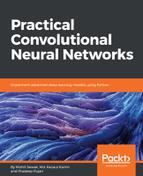A convolution is a mathematical operation that slides one function over another and measures the integral of their pointwise multiplication. It has deep connections with the Fourier transformation and the Laplace transformation and is heavily used in signal processing. Convolutional layers actually use cross-correlations, which are very similar to convolutions.
Thus, the most important building block of a CNN is the convolutional layer. Neurons in the first convolutional layer are not connected to every single pixel in the input image (that is, like FNNs—for example, MLP and DBN) but only to pixels in their receptive fields. See Figure 3. In turn, each neuron in the second convolutional layer is connected only to neurons located within a small rectangle in the first layer:

In Chapter 2, Introduction to Convolutional Neural Networks, we have seen that all multilayer neural networks (for example, MLP) have layers composed of so many neurons, and we have to flatten input images to 1D before feeding them to the neural network. Instead, in a CNN, each layer is represented in 2D, which makes it easier to match neurons with their corresponding inputs.
This architecture allows the network to concentrate on low-level features in the first hidden layer, and then assemble them into higher-level features in the next hidden layer, and so on. This hierarchical structure is common in real-world images, which is one of the reasons why CNNs work so well for image recognition.
Finally, it not only requires a low number of neurons but also reduces the number of trainable parameters significantly. For example, regardless of image size, building regions of size 5 x 5, each with the same-shared weights, requires only 25 learnable parameters. In this way, it resolves the vanishing or exploding gradients problem in training traditional multilayer neural networks with many layers by using backpropagation.
